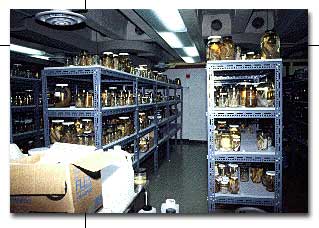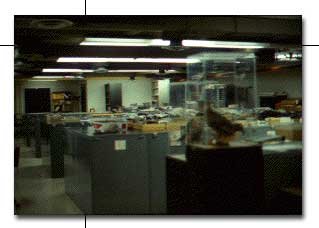|
Dr. William Rowan collected vertebrate specimens from many regions of the world for comparative purposes in the teaching of vertebrate anatomy and biology. Faunal surveys of Alberta (and adjacent regions) were made by Lister and Moore, Dewey Soper, and Dr. R. B. Miller. The early collections of the University of Alberta Museum of Zoology were largely the work of the aforementioned. Dr.s D. A. Boag and V. Lewin, Messrs. N. Panter and W. Roberts have served as curators during the period 1959 to present. During this period, faunal surveys have been taken by museum personnel to fill gaps in our knowledge of the distributions of vertebrates within Alberta. Now acquisitions are largely as a result of collections made by consulting companies, government biological agencies, and department of Zoology staff and graduate students in the courses of their respective studies. Our collections are continually enriched by specimens collected around the world by staff members on sabbatical leave. At present, collection by museum staff is done in the course of life history studies of fish, amphibians, and reptiles of Alberta. |
| The Freshwater Invertebrate
Collection is housed in the Biological Sciences Building as part of the
University of Alberta Museum of Zoology. The most historic part of the collection
includes an extensive group of leech specimens which were collected by Dr.
J. E. Moore and date from 1940. In the 1960's, it became apparent that there
was a need to preserve biological specimens collected by researchers and
graduate students working on rivers, streams, and lakes primarily in Alberta,
but also in parts of northwest Canada. Freshwater invertebrates are used
as bio-indicators to assess ecological changes and the University's collection
provides some pioneer baseline studies for bodies of water that have undergone
major changes, such as the Kananaskis Lakes region and Wabamun Lake.
The Curator of the Freshwater Invertebrates Collection, Dr. Hugh Clifford, used the specimens as a database for his book Aquatic Invertebrates of Alberta, and there have been numerous other scholarly publications based on the collection. It is regularly used for teaching Zoology 351, and graduate students have used the collection to determine species locations or sampling sites. Specimens have been loaned to other departments at the University (e.g., Entomology), to the Northern Alberta Institute of Technology, and to several high school science classes. At present, the Freshwater Invertebrate Collection consists of over 5,000 lots (lots defined as from 1 to [n] specimens per vial; [n] could range from 2 to thousands of specimens for plancton -- microscopic organisms drifting or floating in the sea or fresh water).
The Museum of Zoology's Mammalogy Collection consists of 7,300 specimens representing 16 Orders, and 76 Families. Most of the specimens are "round" skins and skulls (or, to a lesser extent, skin or skull only). Other specimens are skeletons (articulated and disarticulated), and whole, fluid preserved specimens. The collection contains mammals from around the world. However, the majority of specimens are from northwestern Canada. The collection contains old and difficult to obtain material collected by Dr. William Rowan, as well as pioneer survey collections made by Dr.'s Fuller, Murie, and their students. The material provided much of the information used in Mammals of Alberta, and other regional books on mammals.
The University of Alberta Museum of Zoology houses the largest collection of reptiles and amphibians collected within Alberta. A number of specimens from elsewhere in North America and other continents are also included in the collection. Noteworthy exotic specimens include a Sphenodon skeleton, and a large collection of Australian sea snakes. The collection contains valuable historic records providing baseline data for studies involving declines in amphibian populations. These records were instrumental in identifying the disappearance of the northern leopard frog from much of its range in Alberta and are currently serving a similar function in a study of declining Canadian toads. The collection records also provided much of the distributional information for provincial and national books on amphibians and reptiles in Canada and Alberta, as well as a number of scholarly publications. The collection contains over 3,000 amphibians (including specimen lots of eggs and larvae), and 900 reptile specimens.
|
| The Museum of Zoology's Ichthyological Collection consists of over 7,400 lots of more than 200,000 specimens representing 40 Orders and over 200 Families. Most of the specimens are preserved in alcohol with a number of mounted skeletons and cleared and stained specimens. The collection contains a wide variety of fish from around the world as well as a complete systematic collection from the Province of Alberta. The collection features extensive examples of sticklebacks and a number of paratype specimens. The collection also contains research material collected by Drs. J. Ralph Nursall, Joseph S. Nelson, Martin Paetz, Vic Lewin, and Wayne E. Roberts and several graduate and undergraduate students. The material provided much of the information for the book Fishes of Alberta, plus numerous publications in scientific journals from around the world. |  |

